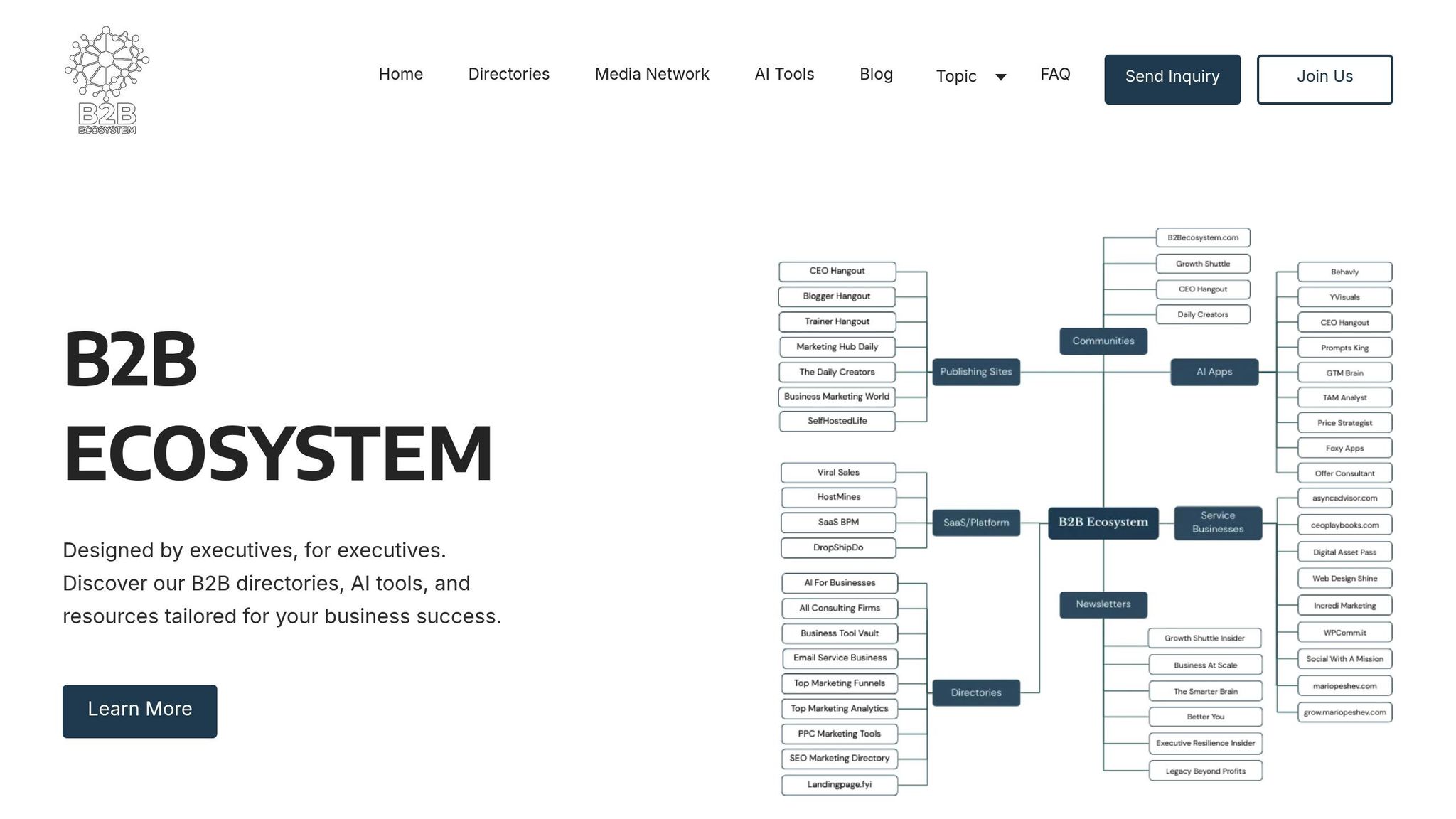Scaling a B2B media network involves growing your audience, increasing engagement, and driving more leads without overextending resources. Custom tools are essential for tackling unique challenges like long sales cycles, marketing-sales misalignment, and limited data visibility. Here's what you need to know:
- Why Custom Tools Matter: They address specific workflow needs, automate repetitive tasks, and adapt to business growth. For instance, AI tools can analyze customer behavior and streamline decision-making.
- Key Challenges: Long sales cycles, budget constraints, skills shortages, and fragmented teams slow growth. Custom tools can help by improving collaboration, data insights, and resource allocation.
- Effective Solutions:
- AI Market Analysis: Provides actionable insights into customer trends and preferences.
- Go-to-Market (GTM) Tools: Align marketing and sales for better lead conversion.
- Workflow Automation: Saves time and reduces bottlenecks caused by understaffed teams.
Finding Growth Barriers and Business Needs
Common B2B Media Network Scaling Challenges
B2B media networks often face hurdles that slow growth and deplete resources. Pinpointing these challenges is crucial to creating tools that solve problems rather than add to them.
Long sales cycles and complex decision-making slow progress. A typical buying group includes six to ten stakeholders, each relying on four to five sources of information that need reconciliation. This makes it difficult to predict deal closures or prioritize leads effectively.
Misalignment between marketing and sales disrupts efficiency. When these teams operate in silos, leads slip through the cracks, messaging becomes inconsistent, and resources are wasted on activities that don't drive revenue. Companies with aligned marketing and sales teams see a 38% higher sales win rate.
Budget constraints and fragmented teams complicate resource allocation. According to Gartner, marketing budgets dropped from 9.5% of company revenue in 2022 to 9.1% in 2023. This tighter budget environment demands smarter spending, but many businesses lack the data to identify which activities yield the best returns.
Skills shortages exacerbate these issues. With 45% of employers struggling to find qualified talent, teams are often understaffed or stretched thin, leading to bottlenecks in areas like content creation and lead qualification.
Weak market positioning adds to the struggle. Standing out in competitive markets becomes harder without clear differentiation. Custom tools can deliver data-driven insights to refine positioning and improve audience engagement.
Limited data visibility hinders decision-making. With 38% of businesses ranking data analytics among their top weaknesses, many companies lack clarity about what works and what doesn’t. This results in wasted investments in ineffective strategies while missing opportunities for growth.
The timing of measurement adds another layer of complexity. Research shows that 70% of marketers assess ROI for B2B campaigns after just one month, even though the average sales cycle spans 192 days. Only 4% measure ROI six months or later, creating a mismatch between expectations and reality.
By identifying these challenges, businesses can focus on developing tools that drive measurable growth and address the root causes of inefficiency.
Matching Tool Development with Business Goals
To overcome these challenges, it’s essential to align tool development with your business objectives. Building tools without a clear connection to your goals wastes both time and money. The process starts with linking specific problems to measurable outcomes before any development begins.
Start with data-driven goals. Companies using marketing analytics report 54% higher profits. Your tools should prioritize gathering and analyzing the right metrics from the outset. As Kevin Hjorslev, CEO & Partner at Profound North, explains:
"Metrics are more than just numbers, they provide insights that help you understand where to focus your efforts, what impacts what and where adjustments are needed."
Define success metrics upfront. Focus on metrics that directly impact your revenue goals, such as customer acquisition costs, lead conversion rates, or sales cycle lengths, rather than vanity metrics that don’t drive decisions.
Address collaboration gaps early. With 59% of B2B operations professionals reporting misalignment with corporate objectives, tools should foster better communication and data sharing across teams. Features that encourage collaboration and unified progress tracking are key.
Build tools for agile budget management. Your tools should help create budgets based on metrics, ensuring every dollar spent ties back to clear campaign goals. This is especially critical when resources are tight.
Adapt to evolving buyer preferences. With 70% of B2B buyers now being millennials who expect intuitive, flexible purchasing experiences, tools need to support modern buying behaviors. This could involve self-service features, personalized content, or solutions that simplify decision-making for buyers.
Focusing on one challenge at a time often leads to better results. For example, Opsfleet revamped its marketing strategy in 2020 to emphasize “Outsourced DevOps teams as a service for growing SaaS startups using Kubernetes and Terraform platforms.” This shift led to 50% MRR growth within six months, all without launching new lead generation campaigns.
Similarly, Idronect refined its targeting and product positioning after interviewing clients. Within two months, they secured five new deals, each worth five times more than previous ones, and even attracted new investment.
The takeaway? Custom tools are most effective when designed to tackle specific, well-defined problems. Before building, map out exactly how each tool will address the obstacles holding back your growth.
Scaling B2B Marketing for Enterprises Using Gen AI
Key Custom Tools for B2B Media Network Scaling
To overcome growth challenges in B2B media networks, specific tools can play a pivotal role. These tools streamline operations, automate repetitive tasks, boost lead generation, and help maximize ROI in today’s fast-moving market.
When choosing tools, it’s crucial to align them with your business goals, budget, team size, and integration needs. Start by creating a checklist of "must-haves", "nice-to-haves", and "non-negotiables" to guide your decision-making. The most impactful tools generally fall into three key categories that directly address scaling hurdles.
AI-Powered Market Analysis Tools
One major challenge businesses face is a lack of data visibility, which can hinder decision-making. AI-powered market analysis tools tackle this by offering deep insights into customer behavior, preferences, and even future trends. These tools make data-driven marketing strategies achievable - something that would be nearly impossible to accomplish manually.
AI’s strength lies in its ability to detect potential issues early, allowing businesses to take preventative measures before problems escalate. It’s no surprise that 89% of top-performing companies are investing in AI to drive revenue growth. Beyond that, AI tools can pinpoint key decision-makers in target accounts and provide insights into their preferences, eliminating much of the guesswork in crafting effective messaging.
For example, in Q1 2024, Khoros used AI-driven intent data from 6sense alongside behavioral data to create highly personalized website experiences. The result? Double the pageviews and four times the number of demos. AI also consolidates data from various sources, offering a unified view of performance metrics. To get the most out of these tools, ensure your data is well-organized and regularly updated so insights stay relevant to current trends.
Go-to-Market Strategy Tools
Misalignment between marketing and sales teams can be a major roadblock. Go-to-market (GTM) tools help bridge this gap by turning complex data into actionable strategies that teams can execute right away. These tools streamline processes, identify inefficiencies, and automate repetitive tasks, making collaboration more seamless.
GTM tools also use customer behavioral data to personalize interactions, anticipate needs, and enhance satisfaction. They allow for real-time adjustments to products and strategies based on market feedback, ensuring businesses stay responsive. Content marketing integration is another critical aspect - 87% of B2B marketers report that content marketing boosts brand awareness. By aligning content strategies with GTM tools, businesses can ensure their messaging resonates with buyers at every stage of the funnel.
Additionally, GTM tools can highlight common reasons for customer drop-off, helping teams make targeted improvements. Alongside strategic planning, automating workflows becomes essential for maintaining efficiency.
Workflow Automation Tools
Skills shortages can create bottlenecks, but workflow automation tools help maintain productivity without requiring immediate headcount expansion. Marketers using these tools can save up to 12.5 hours per week, freeing up time for more strategic tasks. In fact, 52% of U.S. marketing professionals cite increased speed and efficiency as a top benefit of AI-powered automation.
Social media automation ensures a consistent presence across various channels, and when paired with employee advocacy platforms, it’s even more effective - employees often have 10 times the number of connections as company pages. Email automation is another game-changer, simplifying lead nurturing by targeting specific subscriber groups. For instance, B2B marketers who blog see a 67% increase in lead generation compared to those who don’t.
Customer service automation, such as chatbots, can handle up to 80% of routine inquiries, allowing human agents to focus on more complex issues. Content management automation also helps maintain quality across multiple platforms. With 54% of consumers wanting more video content from brands they support, these tools make it easier to produce and distribute content without overloading creative teams.
Finally, setting up automated weekly KPI reports allows teams to quickly adapt campaigns for better results. The key is selecting tools that align with your growth strategy, integrate seamlessly into your workflows, and enhance overall productivity. By automating routine tasks, teams can focus on strategic thinking and creative problem-solving.
sbb-itb-01010c0
How to Develop Custom Tools: Step-by-Step Guide
Creating custom tools for your B2B media network requires a clear and structured approach. By breaking the process into manageable phases, you can ensure each step builds on the last, leading to effective and scalable solutions.
Evaluating Current Performance and Needs
Before diving into tool development, it’s essential to assess where you stand and what you need. Start by defining your goals - what do you want this tool to achieve? Next, analyze key metrics like total sales revenue, churn rate, customer acquisition costs, and new customer acquisition rates to get a solid understanding of your current performance. This groundwork is crucial for building tools that align with your growth objectives.
Take a closer look at your marketing channels. Which ones are driving the best results? Compare revenue across different buyer personas to uncover patterns in customer behavior. Pay particular attention to how your content is performing. Track engagement metrics such as conversions, email and website traffic, and social media interactions. Using tracking URLs can help you pinpoint which efforts are driving results. Additionally, gathering direct feedback from your audience can provide deeper insights into how relevant and valuable your content is to them.
These evaluations help you define the specific requirements and performance benchmarks your custom tool needs to address.
Setting Requirements and Success Metrics
Once you’ve gathered insights, it’s time to turn them into actionable requirements and measurable success indicators. As one expert puts it:
"Clear goals provide a benchmark for evaluating success and ensure both you and your clients stay aligned."
Start by linking your tool’s goals directly to your business objectives. For example, if you’re aiming to boost retention or increase deal volume, define specific metrics for these outcomes. Map out key performance indicators (KPIs) for each stage of your sales funnel: engagement metrics for the top, sales-ready behaviors for the middle, and revenue for the bottom.
Make sure your metrics align with your scaling goals. Collaborate with both marketing and sales teams to create a measurement framework that accurately reflects your processes. Benchmark your performance against industry standards and pull data from multiple platforms to get a comprehensive view. This approach ensures your analysis leads to practical, long-term strategies.
Building and Improving Tools
When you move into development, it’s all about balancing speed and quality. Stick to your defined requirements but remain flexible enough to adapt as you gather data. Use A/B testing to guide decisions based on real-world results. Start small - launch the core features first, and then expand based on user feedback and performance data. This iterative approach helps you avoid overcomplicating things.
Make sure your tracking systems are set up to provide clear attribution. Incorporate personalization and segmentation into your tools to enhance your performance marketing efforts. Design the tools to handle cross-channel data effectively, avoiding the pitfalls of relying solely on last-click attribution. Add data visualization features to simplify complex metrics, making it easier for teams to make informed, data-driven decisions.
Customer feedback is invaluable - use it to refine your tools continuously. Predictive analytics can also provide real-time insights to keep your tools aligned with your evolving needs.
The secret to successful tool development lies in staying focused on your original goals while remaining adaptable to new insights. This structured approach ensures that your tools not only meet current demands but also grow with your business.
Using The B2B Ecosystem for Tool Development

When tackling the challenges of scaling a B2B media network, The B2B Ecosystem offers a streamlined approach to developing custom tools. Instead of starting from scratch or trying to piece together disconnected solutions, this platform provides a suite of AI-driven tools and expert consulting services tailored to address inefficiencies and alignment issues. It's a smarter, faster way to build tools that meet your business needs.
AI Tools and Consulting Services
The B2B Ecosystem's AI-powered tools focus on areas where custom solutions can make the biggest difference. These tools can handle repetitive tasks like lead generation and customer support while delivering actionable insights by analyzing large datasets. This helps businesses make smarter decisions, predict trends, and better understand customer behavior.
Key tools include:
- GTM Brain: A tool for refining go-to-market strategies.
- TAM Analyst: Designed for in-depth market analysis.
- AI Process Optimizer: Focused on modernizing and streamlining business processes.
These tools not only enhance operational efficiency but also create a robust foundation for scaling. They support various content formats, from blog posts and social media updates to marketing ads and SEO-driven pages. Combined with strategic consulting services, these tools provide a comprehensive solution for businesses aiming to grow.
The numbers back it up. AI implementation has been shown to increase lead capture by 35% and reduce support workloads by 40%. Additionally, 68% of marketers report that AI has significantly advanced their careers.
But it’s not just about the technology. The B2B Ecosystem also offers consulting services to help businesses navigate growth strategies and the complexities of the B2B landscape. These advisory services are tailored to help executives not only implement tools but also identify new opportunities for services and offerings - critical when expanding into new markets or verticals.
Case Study: Growing with The B2B Ecosystem
The success stories speak volumes. For example, Nestermind revamped its CRM system and achieved faster sales cycles and doubled its pipeline visibility - all within four weeks. This kind of rapid transformation highlights how combining the right tools with expert guidance can accelerate growth.
GAIA's results are equally impressive, resolving challenges in under three months. The outcome? Over 30 booked calls with ideal customer profiles (ICPs) and a 2× increase in website visitors driven by more than 2,000 content engagements. For media networks, this level of engagement often translates directly into higher ad revenue and stronger partnerships.
Longer-term partnerships show the scalability of these solutions. Boostbar grew its annual recurring revenue (ARR) from $0 to $10 million in just three years. Similarly, Classtime achieved over 8× ARR growth in less than three years by closing deals 10–50× larger than before and building a scalable outbound sales engine. These examples demonstrate how custom tools and strategic advice can improve both the quantity and quality of deals - key for monetizing media networks.
For businesses looking to enter markets quickly, the results are just as compelling. Kyan Health hit a seven-figure ARR in under 12 months, while rready scaled from $0 to over $2 million ARR in just 18 months. These timelines show that with the right support, rapid scaling is achievable.
The consulting aspect is just as impactful. Deskbird exceeded its sales target by 153% in the first quarter after implementing strategic guidance, and Care4IT closed a $30,000 deal in under three months. These examples highlight how expert advice can amplify growth and deliver compounding benefits.
The B2B Ecosystem's approach doesn't just stop at tools and consulting - it tackles the full range of scaling challenges. Its AI solutions integrate data sources, ensuring better quality and consistency. This leads to sharper insights, smarter decision-making, and more effective ad targeting. For growing media networks, managing complex audience and revenue streams becomes far more manageable with this level of data integration.
Key Takeaways for Scaling with Custom Tools
Custom tools play a crucial role in staying competitive in today’s fast-moving B2B landscape. They help businesses automate repetitive tasks, generate better leads, and improve ROI. The numbers back this up: AI-powered tools can save up to 12.5 hours per week, and employees’ personal networks are 10 times larger than company pages, significantly boosting engagement. With 87% of B2B marketers reporting that content marketing increases brand awareness, having the right tools is essential for scaling these efforts effectively.
One of the biggest advantages of custom tools is their ability to remove barriers to growth. By automating manual tasks, they free up revenue teams to focus on delivering personalized experiences with less effort. This is especially important when you consider that buyers typically interact with 11+ pieces of content across 30 or more touchpoints before ever speaking to a sales representative. With custom tools, sales teams can spend more time on meaningful conversations rather than administrative work, leading to better lead quality and stronger customer engagement.
"Without clear mapping of the customer journey, even strong email campaigns yield minimal results." – New York Times
Tracking the right metrics is key. In B2B, success is built on relationships, high-quality leads, and measurable business impact. Smart companies monitor pipeline velocity, deal size, and customer lifetime value - metrics that directly affect their bottom line. For instance, LinkedIn generates 97% of all B2B leads, while X contributes 13% and Facebook trails at just 7%.
When choosing tools, it’s important to align them with your business goals, budget, team size, and integration needs. Set clear criteria for selection and automate weekly KPI reports to quickly adapt campaigns and optimize results.
The B2B Ecosystem’s AI tools and consulting services illustrate how these strategies can drive growth. Tools like GTM Brain, which sharpens go-to-market strategies, and TAM Analyst, designed for market analysis, provide a solid foundation for scaling efficiently.
B2B success is about building relationships and creating long-term value. Unlike B2C, which often focuses on quick sales, B2B sales cycles can take months. Consistent engagement is more important than speed. Custom tools make it easier to maintain this engagement while scaling operations effectively.
FAQs
How can custom tools help align marketing and sales teams in B2B media networks?
Custom tools are essential for bringing marketing and sales teams together within B2B media networks. They provide a shared platform that encourages collaboration and smooth communication. By integrating data seamlessly, these tools help both teams align their efforts, share insights in real time, and simplify workflows.
With the help of analytics and AI-driven insights, these tools enable teams to pinpoint high-value prospects, monitor performance metrics, and stay focused on shared objectives. This unified strategy doesn’t just boost efficiency - it also delivers stronger results throughout the sales pipeline.
What key metrics should you monitor when creating custom tools to grow a B2B media network?
When creating custom tools to grow your B2B media network, keeping an eye on the right metrics is crucial. These numbers give you a clear picture of your progress and help pinpoint areas that need attention. Here are some key metrics to monitor:
- Lead conversion rate: This tells you how effectively you're turning potential leads into actual customers.
- Customer acquisition cost (CAC): Tracks how much you're spending to gain each new customer.
- Marketing qualified leads (MQLs): A measure of the quality of leads your campaigns are bringing in.
- Pipeline velocity: Shows the speed at which leads move through your sales funnel, from prospect to customer.
- Return on marketing investment (ROMI): Helps you understand how profitable your marketing efforts are.
- Customer retention rate: Indicates how successful you are at keeping your current customers engaged.
- Customer churn rate: Tracks the percentage of customers you lose over a certain period.
- Net promoter score (NPS): Gauges customer satisfaction and loyalty by asking how likely they are to recommend your business.
By analyzing these metrics, you can fine-tune your strategies, improve efficiency, and set your B2B media network on a path to long-term success.
How do AI-driven market analysis tools help improve strategy and decision-making in B2B media networks?
AI-powered market analysis tools give B2B media networks a powerful way to understand market trends, customer behaviors, and campaign performance. With access to these insights, businesses can make smarter decisions, adjust strategies effectively, and adapt quickly to shifting market conditions.
These tools also allow companies to predict future outcomes, automate content targeting, and simplify marketing processes. This not only cuts down on guesswork but also boosts efficiency and maximizes ROI - helping businesses stay ahead in a competitive landscape.


